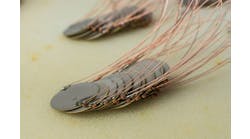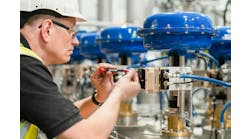It’s easy, in this chosen profession of control design, to lose focus on the little bits that make up our products in deference to the bigger picture. Vendors are always toting new products; the Internet is chock full of information on what the “smart” customers are using to be competitive; and all of that can be a great distraction when we have a project in front of us.
It is human nature to push the chatter off to the side so we can stay connected to the task at hand. It was in one of those shrouded moments when something popped up out of the blue that I thought I would share with you all.
I was attending an equipment checkout this past week with several of my colleagues. The “usual cast of characters” attending these events gives our group an opportunity to view these new products from various vantage points, based on our particular areas of expertise.
I have to admit that I was not as focused as I usually am on such events, but, in my own defense, I had seen the machine several times over the past six months. We have a preference for forming close partnerships with equipment vendors and leverage these relationships to help both our vendor and ourselves to think outside the box and try out new things. This particular machine is no exception.
We have about 30 horizontal packagers in our inventory. All of these are based on a single machine brand, first produced in the late 1960s. While most are pretty much the same controls package as the original offerings, some of these have been updated, either by us or by other vendors who have carved out a niche by offering modern control systems on these popular, intermittent motion packagers.
The original machine used a single drive with all functions based on cams mounted to the main cycle shaft. The newer conversions that we purchased offered servo control of a decoupled system where the machine cycle shaft, indexer and film feed systems are independently driven.
We have had these refurbished machines for the better part of 12 years, and, good and bad, we have some in-depth experience that made a partnership very beneficial when looking at more horizontal packaging machines.
I mention vendor partnerships often because I really think these are the future of automation. Coming from an OEM background, I remember that our livelihood was based entirely on client need. As a machine builder, we were dependent on the client having a need to produce a product in a different way. Sometimes we were lucky and had a sales representative that was good at helping the client to identify a need where the client may not have realized one existed.
This particular partnership probably originated out of convenience at first as the vendor is located less than an hour from our facilities. Over the years, we’d counted on the vendor’s specific expertise with replacement parts for our large inventory of horizontal packagers. While we were aware of the vendor’s capacity to rebuild and produce new machines, it wasn’t until about two years ago that we began entertaining the idea of having a new machine built for us.
Unlike most capital purchases, we didn’t have a particular product in mind for this new machine, so we decided to put as many features as possible into this unit so we wouldn’t be limited by capabilities. Both teams attacked this process with zest and the resulting machine is quite the thing to see.
It’s easy, with all that was going on with this long build project, to overlook the fine details that go into building a packaging machine. The control system is modern, with a PAC driving multiple servos and variable-frequency drives on a common Ethernet I/P network.
This base control allowed us to add a lot of wish-list items to the machine function. There are lots of coordinated motion activities, and plenty of thought has gone into normal and abnormal stopping of the machine and what actions would take place to quickly recover the machine to a known position for restart.
The factory acceptance test that day generated the usual scrutiny associated with such an event and the overall experience was very positive. The vendor delivered a machine that was everything we asked for.
Lost in all the hubbub of activity was the function of an obscure part of the machine that might have been totally overlooked had I not been admiring the electrical panel and just happened to notice a device sitting on a cart beside the machine. While it was being used in the control system, it had yet to be mounted on the finished assembly.
On many production machines that work with web media, the passage of the media through the machine is managed through the use of a sub-assembly called a dancing bar. The purpose of the bar is to respond to the pulling of web (film) off a roll by contracting a bar, or series of bars, to straighten out the path of the web and then, when the web stops pulling, relax the bars into an extended position that pulls additional web off the roll to make up the relative length of the next web pull.
The point of this assembly is to isolate the pulling of the roll linearly from the unwrapping the web off a cylindrical roll. This process is the same for sheet-metal processing as it is for newspaper production and for the making of pouches for food and mechanical parts.
Traditional control of a dancing bar comes in two forms, mechanical springs or motor/servo control to relieve the bar and then bring it back to a starting position. For this particular type of machine, the dancing bar is usually mounted on a rack and pinion with mechanical springs to absorb the pull of the linear drive and then relax back to the original position to pull out enough film (web) for the next index.
What was unique about this particular application was the use of a pair of air-actuated cylinders. Normally, air is not used for such an action due to the compressibility of air. In this situation, however, the vendor had sourced a proportional valve, monitored and activated by analog signals. What was surprising to me is I have used proportional valves in hydraulic applications but never even considered that it might be used for air.
This revelation probably has some of you thinking, “What the heck has Rick Rice been doing all these years?” I have to admit I was somewhat reluctant to write about this, but I finally decided to discuss it because I don’t think I’m alone in thinking that, despite our best intent, we only know what we are exposed to.
I have been so busy doing my job that I missed a development that has been in use for at least 14 years and likely more. I started researching the use of pneumatic proportional valves and was startled to discover they aren’t very new after all.
What I especially like about the solution I viewed that day was the use of an analog proximity sensor to monitor a lobe on a cam at the pivot point of the dancing bar. By using this feedback single, the control of the valve can be quite precise. The lobe is shaped so that the full retract of the dancing bar provides the largest feedback signal while the motion toward the resting position results in a parabolic feedback that gets ever finite as it gets closer to the endpoint. The tension on the film web is very smooth and reduces the tendency to snap as the dancing bar makes its movements.
There are many lessons to be learned from this particular situation. The primary one for me was the benefit of collaboration. We learn more when we put our collective minds to an objective. The unique combination of a world-class machinery OEM with a company that has been in the contract packaging business since the late ’60s brought about a team of highly creative individuals who worked for over a year to elevate the performance of an already well-performing piece of machinery.
The secondary, although perhaps dual primary, lesson in this was the importance of taking time to expand the focus when considering our designs. We can build in our own obsolescence by going back to our successful designs over and over again out of convenience. Sometimes it is best to take some time and, to use and old saying, “smell the roses.”






